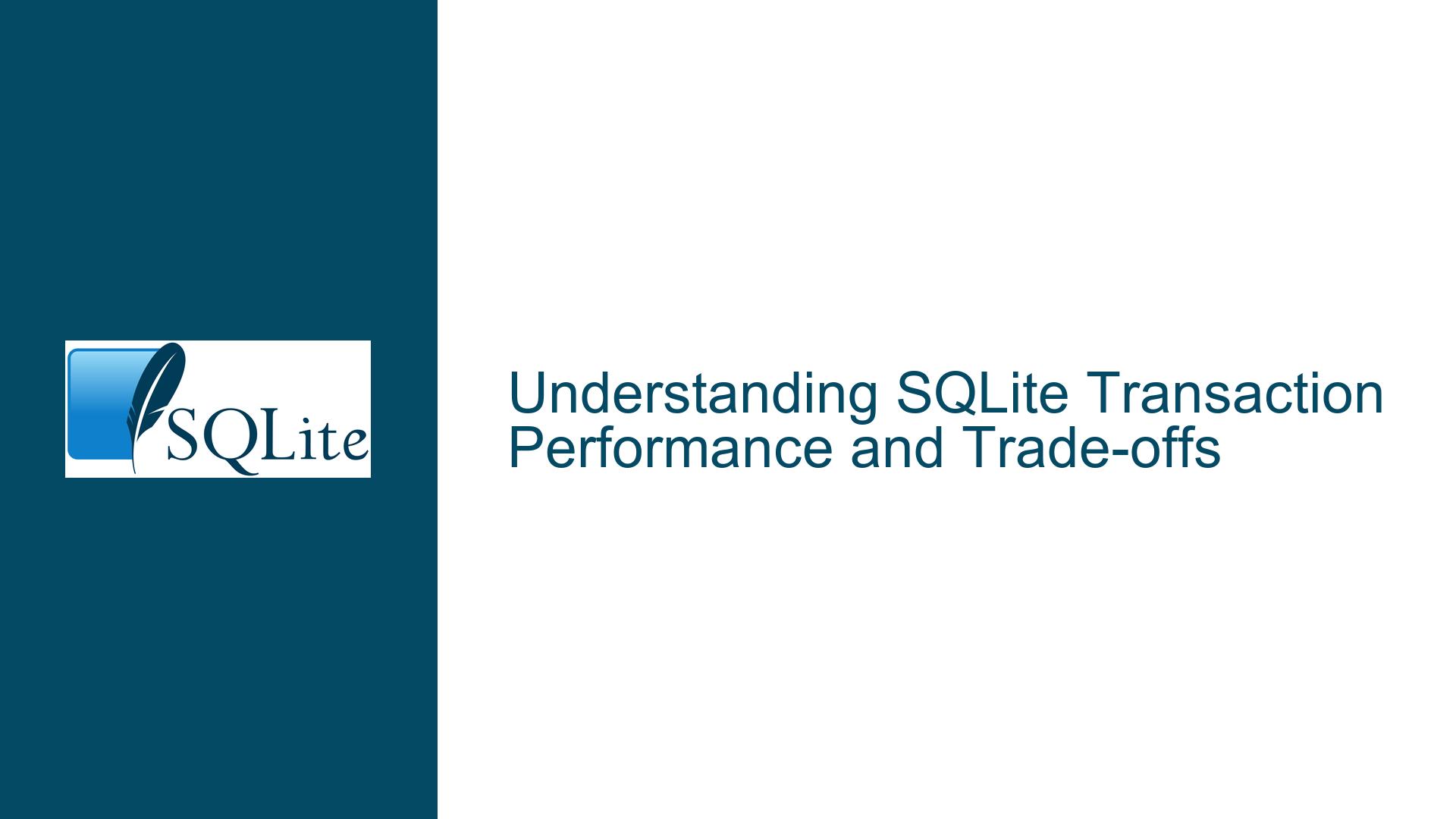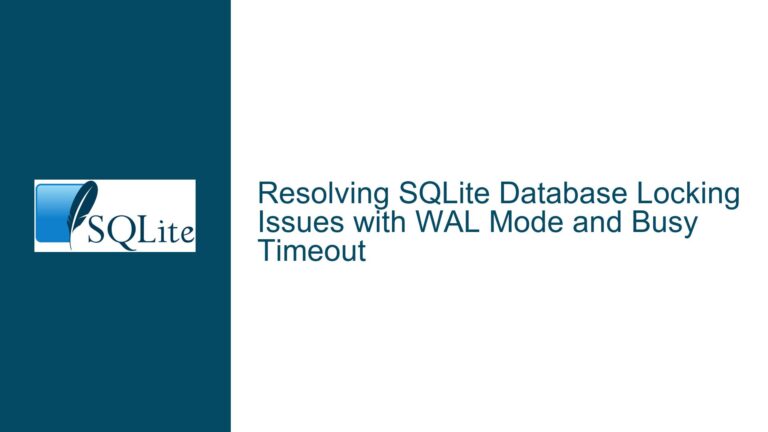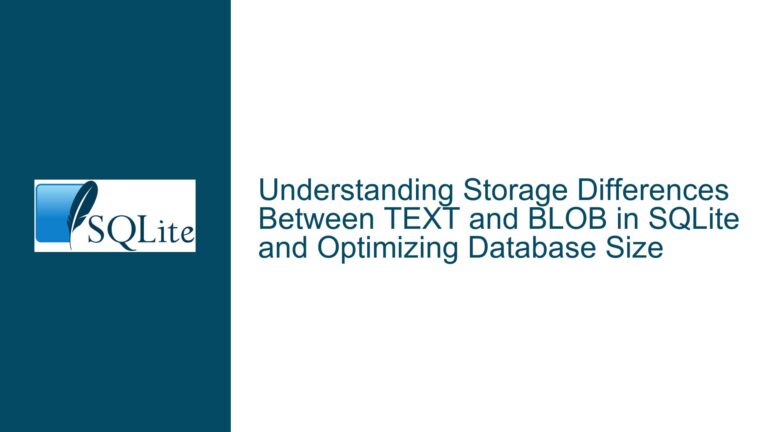SQLite Transaction Performance and Trade-offs
The Role of Transactions in SQLite Performance Optimization
Transactions in SQLite are a powerful tool for optimizing database performance, particularly when dealing with write operations such as INSERTs and UPDATEs. When multiple write operations are grouped within a transaction, SQLite can significantly reduce the overhead associated with disk I/O operations. This is because, without transactions, each write operation would typically require a separate disk write, which is inherently slow due to the physical limitations of storage devices. By batching these operations within a transaction, SQLite can defer writing to disk until the transaction is committed, thereby reducing the number of disk writes and improving overall performance.
The performance gains from using transactions can be substantial, often resulting in a 20x speed-up or more, depending on the workload. This is especially true for workloads that involve a high volume of small, frequent write operations. However, the benefits of transactions come with trade-offs, particularly when it comes to data durability and the risk of data loss in the event of a crash or power failure. Understanding these trade-offs is crucial for making informed decisions about how to configure and use SQLite in your application.
The Trade-off Between Performance and Data Durability
One of the key trade-offs when using transactions in SQLite is between performance and data durability. By default, SQLite operates in a mode where it ensures that all changes made within a transaction are safely written to disk before the transaction is considered complete. This is achieved through the use of the synchronous pragma, which controls how aggressively SQLite flushes data to disk. When synchronous is set to FULL (the default), SQLite ensures that all data is written to disk before the transaction is committed, which provides a high level of data durability but can be slow.
However, if you are willing to accept a higher risk of data loss in the event of a crash or power failure, you can set synchronous to OFF. This tells SQLite to defer writing data to disk, which can result in significant performance improvements. The downside is that if a crash occurs before the data is written to disk, the database could become corrupted, and you could lose all changes made since the last successful commit. This trade-off is particularly relevant for applications running in environments where power failures are rare, such as cloud hosting platforms like DigitalOcean.
Another approach to balancing performance and data durability is to use "grouping transactions." This involves opening a transaction and holding it open for a certain period of time or until a certain number of write operations have been performed. While this approach can improve performance by reducing the number of disk writes, it also increases the risk of data loss. If a crash occurs while the transaction is open, all changes made within that transaction will be lost. This can be problematic for applications where data integrity is critical, as losing a minute’s worth of data or 1,000 write operations could be unacceptable.
Exploring Savepoints and Alternative Strategies
Savepoints offer a way to mitigate some of the risks associated with grouping transactions. A savepoint is a point within a transaction to which you can roll back without affecting the entire transaction. This allows you to create "sub-transactions" within a larger transaction, providing a way to handle errors or partial failures without losing all the work done within the transaction. For example, if you have a set of related write operations that need to be atomic, you can use a savepoint to ensure that either all of them succeed or none of them do.
However, savepoints do not address the issue of data loss in the event of a crash. If a crash occurs while a transaction is open, any changes made within that transaction, including those within savepoints, will be lost. This means that while savepoints can help with error handling and atomicity, they do not provide a solution for the trade-off between performance and data durability.
One alternative strategy for improving performance while minimizing the risk of data loss is to use a hybrid approach that involves multiple database files. In this approach, you create a temporary database file to handle incoming write operations. Since this temporary database is small and only used for incoming data, it can be very fast for write operations. Once a certain amount of data has been accumulated in the temporary database, you can transfer it to the main database in a single transaction. This approach allows you to batch write operations and reduce the number of disk writes, while also minimizing the risk of data loss. If a crash occurs, you would only lose the data in the temporary database, which could be a small fraction of the total data.
Another strategy is to use a combination of synchronous and asynchronous writes. For example, you could set synchronous to OFF for the temporary database, where the risk of data loss is acceptable, and keep it set to FULL for the main database, where data durability is critical. This approach allows you to achieve a balance between performance and data durability, but it requires careful management of the data transfer process between the temporary and main databases.
Real-world Considerations and Best Practices
In real-world applications, the choice between performance and data durability often depends on the specific requirements of the application. For example, if your application involves a high volume of small, frequent write operations and data loss is acceptable (e.g., logging or analytics data), you might opt to use grouping transactions with synchronous set to OFF. On the other hand, if data integrity is critical (e.g., financial transactions or user data), you might prefer to use smaller transactions with synchronous set to FULL, even if it means sacrificing some performance.
It’s also important to consider the impact of read operations on your database performance. If your application performs a large number of read operations alongside write operations, the performance benefits of grouping transactions may be less pronounced. In such cases, you might need to explore other optimization strategies, such as indexing, query optimization, or even switching to a different database system that is better suited to your workload.
Finally, it’s worth noting that the performance characteristics of SQLite can vary depending on the specific workload and environment. For example, the performance benefits of transactions may be more pronounced on systems with slower storage devices, such as spinning hard drives, compared to systems with faster storage, such as SSDs. Similarly, the impact of synchronous settings may vary depending on the underlying file system and operating system. As such, it’s important to conduct thorough benchmarking and testing in your specific environment to determine the optimal configuration for your application.
In conclusion, transactions are a powerful tool for optimizing SQLite performance, but they come with trade-offs that need to be carefully considered. By understanding the role of transactions, the trade-offs between performance and data durability, and the various strategies for mitigating these trade-offs, you can make informed decisions about how to configure and use SQLite in your application. Whether you choose to use grouping transactions, savepoints, or a hybrid approach, the key is to find the right balance between performance and data integrity that meets the needs of your application.






